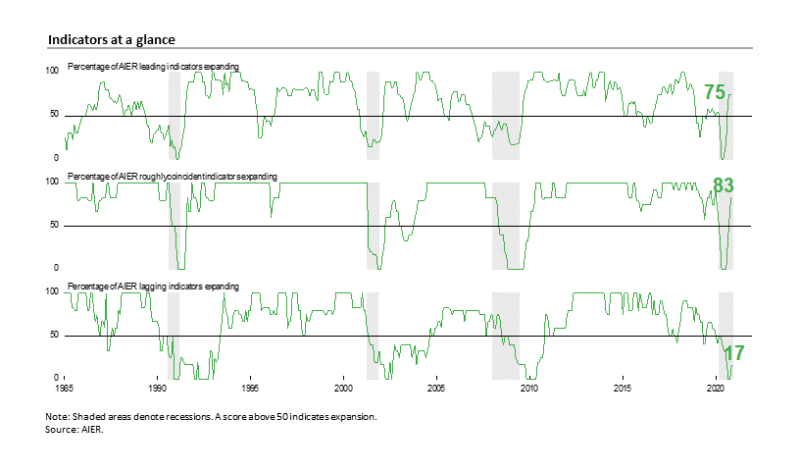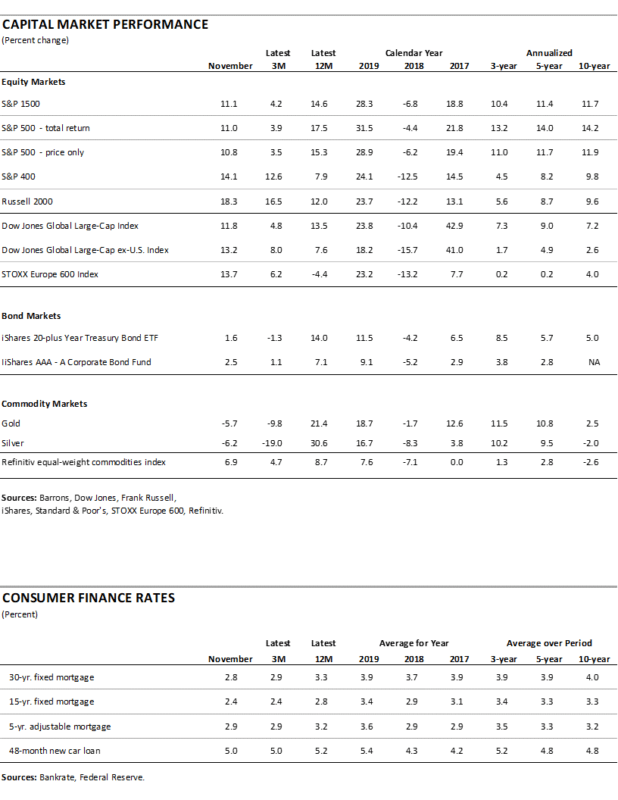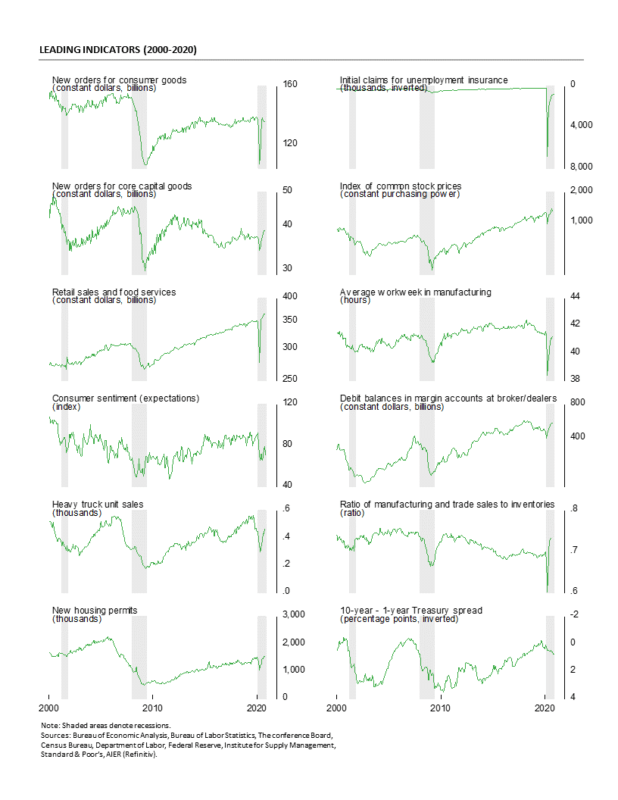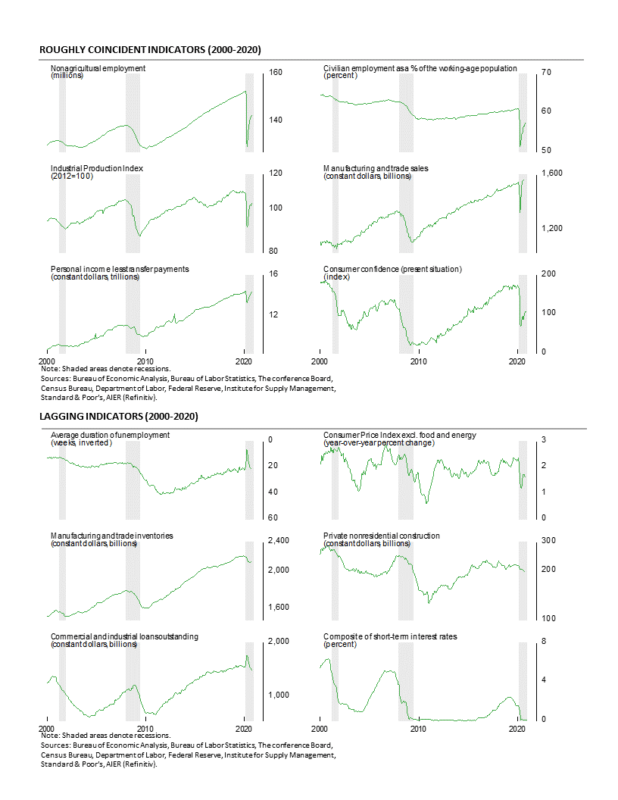AIER’s Leading and Roughly Coincident Indexes Were Favorable in November
The U.S. economy likely expanded again in November, continuing the recovery from an unprecedented economic contraction caused by government policy. However, doubts are rising regarding the outlook for continued growth as the potential for renewed lockdown policies increases.
AIER’s leading and coincident indexes remained solidly above neutral in November with the Leading Indicators index holding steady at 75 and the Roughly Coincident Indicators index increasing to 83. The Lagging Indicators index posted a gain for the month but remained well below neutral at 17. Though the Leading Indicators index was unchanged for the month, three consecutive months above the neutral 50 level suggest the economy is likely to continue expanding in coming months (see chart). Furthermore, two consecutive months above neutral for the Roughly Coincident Indicators index suggest the economy is already growing and that the recession that began in February may be over.
However, with Covid-19 cases surging around the country, new restrictions on consumers and businesses are a growing threat to continued expansion. While most policymakers have learned that widespread lockdowns are not the most effective course of action, even target restrictions represent a significant threat to the economy.
These threats are reflected in surveys of small businesses that were especially hard hit by lockdowns, as well as surveys of consumers. The surveys show improving views of current conditions as economic activity picks up but declining views of the future as the potential for restrictions grows. The views of improving current activity are backed up by economic statistics. However, a number of economic statistics also reflect the uneven recovery and suggest caution as the risk of a double-dip recession lingers.
AIER Leading Indicators index points to continued expansion
The AIER Leading Indicators index held steady at 75 (on a scale of 0 to 100) in November, the third consecutive month above the neutral 50 threshold. The October and November results are the highest readings since November 2018.
There were no changes among the 12 leading indicators in November. The overall results among the leading indicators show nine indicators in uptrends, three indicators still in downtrends, and none in neutral trends compared to eight indicators in a positive trend, four in negative trends and none with neutral trends in September.
The Roughly Coincident Indicators index increased to 83 in November, up from 58 in October. November was the second consecutive month above neutral and suggests the economy is expanding.
Two roughly coincident indicators changed signs in September: industrial production and the Consumer Confidence index for the present situation from The Conference Board. Industrial production improved from a negative trend to a positive in the latest month while the consumer confidence indicator improved from a neutral trend to a positive trend.
Overall, five roughly coincident indicators had positive trends in November while one remained in a negative trend and none were in a neutral trend versus three indicators trending favorably, two trending unfavorably and one with a neutral trend last month.
AIER’s Lagging Indicators index rose to 17 in November, matching the result from August and following two months at the lower bound of zero in September and October. One indicator changed in November as the composite of short-term interest rates moved from an unfavorable trend to a favorable trend. The remaining five lagging indicators remained in negative trends in November.
Overall, consecutive months above neutral for both the Leading Indicators index (three) and the Roughly Coincident Indicators index (two) suggest that the end of the recession may have occurred or is imminent and that continued expansion is the most likely path. However, the National Bureau of Economic Research is unlikely to declare an official end to the recession for some time as the risk of a double dip recession remains. With new Covid-19 cases on the rise again, the potential for renewed restrictive policies suggest the outlook for the economy remains highly uncertain.
Small-Business Survey Shows Mixed Expectations in October
The small-business-optimism index from the National Federation of Independent Business was unchanged at 104.0 in October. The latest result is about in line with results from 2019 and reflects a substantial recovery from the 90.9 reading in April 2020. Details within the report suggest that small-business owners remain fairly optimistic about future general economic conditions but are somewhat less optimistic about their own business.
Within the details of the small business survey, the net percentage of respondents expecting better economic conditions (“better” minus “worse”) fell to 27 in October versus 32 in September. While the monthly decline suggests some deterioration in expectations, the index remains at a reasonably favorable level.
However, while a net 11 percent expect higher sales over the next three months versus the prior three months, an improvement from the net 8 percent in September, the 11 percent result is generally weak compared to results from 2017 through 2019, suggesting a significant amount of caution. A net 6 percent of all owners (seasonally adjusted) reported higher nominal sales in the past three months, up 12 points from a -6 percent in September.
Along with the somewhat contrasting results from the expectations for the economic outlook (generally favorable) and the outlook for sales (generally weak), the percentage of respondents believing now is a good time to expand came in at 13 in October, unchanged from the previous month, and a generally weak result compared to the 2017 through 2019 results.
Twenty-seven percent of firms have plans for capital expenditures over the next three to six months, down from 28 percent from the prior month but about in line with 2019. Fifty-three percent of small businesses have made capital expenditures during the past six months. That is below the typical percentage in the upper 60s during the late 1990s but above the mid-40s percentages during the 2008-09 recession. The most popular type of expenditure was equipment (36 percent) followed by vehicles (20 percent) and building/land improvement (16 percent). The most popular outlay range was $10,000 to $49,999.
The percentage of firms planning to increase employment fell to 18 percent in October versus 23 percent in September, matching the result from July and about in line with the results from 2017-2019. Surprisingly, 33 percent of firms (down from 36 percent in September) still report having openings they are not able to fill at the moment despite the elevated level of unemployment. The percentage of firms reporting few or no qualified applicants for job openings was 48 percent, down from 50 percent in September but still a high level. The results suggest there is a skills shortage in the U.S.
That skills shortage has 23 percent of firms saying they have already increased compensation over the past three months while 18 percent intend to increase worker pay over the coming months.
The skills shortage is keeping quality of labor at the top of the most important issue for small businesses. Among the 10 issues listed in the survey, quality of labor again ranks first at 22 percent, 5 points below the survey high of 27 percent. Taxes were second at 17 percent while government regulation (red tape) was third at 14 percent and poor sales was fourth on the list at 13 percent.
Overall, the survey suggests that the small-business sector of the economy remains somewhat optimistic about the outlook for the economy but remains a bit more cautious about its own future. Still, while small businesses may not believe it’s a good time to expand, they are looking to hire employees and make some capital expenditures. Finally, despite the weak labor market, a shortage of skilled workers continues.
Consumers grow less optimistic about the short-term outlook in November
The Consumer Confidence Index from The Conference Board fell in November, decreasing by 5.3 points to 96.1. The index is constructed so that it equals 100 in 1985. Overall consumer confidence is in the middle of its long-term historical range, but well below the pre-pandemic level.
Both components of the index fell for the month though the drop was much more severe for the expectations component. The present-situation component fell 0.3 points to 105.9 while the expectations component sank 8.7 points, taking it to 89.5 from 98.2 in the prior month.
For the present situation component, The Conference Board report says, “Consumers’ assessment of present-day conditions held steady, though consumers noted a moderation in business conditions, suggesting growth has slowed in Q4.” The report also noted, “The percentage of consumers claiming business conditions are ‘good’ declined from 18.6 percent to 17.6 percent, but those claiming business conditions are ‘bad’ also decreased, from 34.4 percent to 33.5 percent. Consumers’ assessment of the labor market was unchanged. The percentage of consumers saying jobs are ‘plentiful’ held steady at 26.7 percent, while those claiming jobs are ‘hard to get’ was virtually unchanged at 19.5 percent.”
Regarding the expectations component, the report states, “Consumers, however, have grown less optimistic about the short-term outlook. The percentage of consumers expecting business conditions will improve over the next six months decreased from 36.0 percent to 27.4 percent, while those expecting business conditions will worsen increased from 15.9 percent to 19.8 percent.” Furthermore, the report adds, “Consumers’ optimism regarding the job market also weakened. The proportion expecting more jobs in the months ahead declined from 32.0 percent to 25.9 percent, while those anticipating fewer jobs increased moderately from 19.8 percent to 20.5 percent.”
The changes for the month closely match the results from the University of Michigan Survey of Consumers. That report suggests that the resurgence of Covid-19 is increasing uncertainty and exacerbating concerns about the outlook among consumers.
Overall consumer sentiment in the University of Michigan survey decreased to 76.9 in November, down from 81.8 in October, a 6.0 percent decline. From a year ago, the index is down 20.6 percent. The sub-indexes had mixed results in November. The current-economic-conditions index rose to 87.0 from 85.9 in October. That is a 1.3 percent gain and leaves the index with a 22.0 percent decrease from November 2019. The second sub-index — that of consumer expectations, one of the AIER leading indicators — sank 8.7 points or 11.0 percent for the month to 70.5 and is 19.2 percent below the prior year.
According to the report, “The November data were less optimistic than last month due to the resurgence in Covid infections and deaths as well as partisan shifts due to the outcome of the presidential election.” Weakening sentiment and resurging infections along with renewed restrictions may act as a restraint on consumer spending and overall economic activity, resulting in a slower and more drawn out recovery.
Overall, consumer attitudes remain cautious. The two surveys suggest that the election and the surging number of new Covid-19 cases are weighing on consumers’ minds. Pessimism about jobs and the economy, whether a result of economic policies or the coronavirus, may restrain consumer spending and harm the economic recovery.
Retail spending hits a record in October but breadth narrows
Retail sales and food-services spending posted another gain in October, rising 0.3 percent from the prior month. The October gain was the sixth in a row following two devastating declines in March and April. October is the fifth consecutive record high. Core retail sales, which exclude motor vehicles and gasoline retailers, posted a 0.2 percent gain for the month putting them well above trend and at the fifth consecutive record high as well.
From a year ago, total retail sales are up 5.7 percent while core retail sales show a 6.5 percent rise. Both are back to the growth rates achieved just before the outbreak of Covid-19 and implementation of government lockdown policies. The current 12-month rates are well above the five-year annualized rates of 3.7 percent and 3.9 percent, respectively, for the five years from 2015 through 2019.
Despite posting another record high, results across the various categories of retailers were mostly weaker in October. Eight of the thirteen major categories reported declines in October sales. Decliners were led by clothing and accessories stores and sporting goods, hobby, musical instrument, and bookstores, both posting declines of 4.2 percent. Gainers were led by a 3.1 percent gain for nonstore retailers, primarily online shopping.
The October results leave five of the 13 categories with sales below their pre-lockdown levels. Gasoline stations and restaurants are both 15 percent below January followed by clothing and accessory stores (14 percent below), electronics and appliances (5 percent below), and miscellaneous store retailers (2 percent below).
On the upside, nonstore retail sales are 29 percent above January 2020 levels. Nonstore retail sales now account for 15.9 percent of total retail sales, up from 12.9 percent in January 2020 (before the pandemic) and about 8 percent at the beginning of 2012. As a share of core retail sales, nonstore sales account for 21.9 percent, up from 17.9 percent in January and 11.7 percent at the start of 2012.
Retail sales rose to another record high in October as widespread quarantines and lockdowns continue to be eased, and shoppers shift more spending to online retailers. Businesses and consumers continue to emerge from the policy-induced economic coma. However, while aggregate retail spending is at a new high, results still vary greatly by industry.









